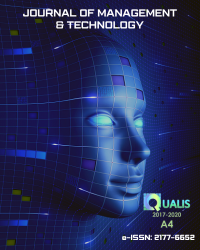Arquitetura de empresa em rede baseada em tecnologia multiagente
DOI:
https://doi.org/10.20397/2177-6652/2024.v24i00.2719Palavras-chave:
Cadeia de valor, Gêmeo digital, Fio digital, Sistema de produção ciberfísico, Casca administrativa de ativos, Tecnologia multiagenteResumo
Objetivo: O artigo tem como objetivo desenvolver uma arquitetura flexível para empresas em rede, baseada na tecnologia multiagente. O objetivo é permitir a configuração dinâmica de cadeias de valor envolvendo diversos parceiros de negócios e fornecer um quadro adaptável para a criação de produtos inovadores por meio do uso de gêmeos digitais e threads digitais.
Métodos: A pesquisa utiliza o modelo RAMI (Modelo Arquitetural de Referência para a Indústria 4.0) para projetar a arquitetura das empresas em rede. A tecnologia multiagente é utilizada para garantir a integração dos processos empresariais em diferentes níveis de gestão, combinando a integração horizontal e vertical. A implementação de sistemas ciberfísicos por meio de gêmeos digitais e da Casca de Administração de Ativos é central para essa abordagem.
Resultados: A arquitetura proposta demonstra a capacidade de configurar de maneira flexível os processos produtivos, adaptando-se às mudanças nas necessidades de mercado e nas restrições técnicas. O uso da tecnologia multiagente aprimora a adaptabilidade, confiabilidade e escalabilidade da empresa, garantindo uma comunicação fluida entre os sistemas digitais e físicos.
Contribuição: Esta pesquisa contribui ao avançar o uso da tecnologia multiagente em empresas em rede, destacando seu papel na transformação digital da produção. A integração dos gêmeos digitais e do modelo RAMI possibilita maior eficiência na gestão de cadeias de valor, melhorando o tempo de resposta às mudanças dinâmicas e garantindo maior flexibilidade nas operações empresariais.
Conclusões: O estudo conclui que a combinação da tecnologia multiagente com o modelo RAMI oferece uma arquitetura robusta para empresas em rede. Essa abordagem permite a reconfiguração rápida dos processos produtivos e melhora a eficiência e adaptabilidade das empresas em ambientes de mercado competitivos. Sugere-se que pesquisas futuras explorem mais cenários operacionais e garantam a adequação funcional e a segurança do sistema.
Referências
Almada-Lobo, F. (2015). The Industry 4.0 revolution and the future of Manufacturing Execution Systems (MES). Journal of Innovation Management 3(4), 16-21. http://dx.doi.org/10.24840/2183-0606_003.004_0003
Association Tekhnet. (2019). Digital twins in the high-tech industry. Expert and analytical report. Мoscow: Technet Infrastructure Center, 50 p. http://assets.fea.ru/uploads/fea/news/2019/12_december/28/cifrovoy_dvoinik.pdf (accessed on October 10, 2023).
Association Tekhnet. (n.d.). Multi-level structure of the factory of the future. https://technet-nti.ru/article/fabriki-buducshego (accessed on October 10, 2023).
Bajaj, M., & Hedberg, T. (2018). System lifecycle handler – Spinning a digital thread for manufacturing. INCOSE International Symposium, 28(1), 1626-1650. http://dx.doi.org/10.1002/j.2334-5837.2018.00573.x
Belyaev, A., & Diedrich, C. (2019). Specification "Demonstrator I4.0-Language" v3.0. Technical Report IFAT-LIA 07/2019. University of Magdeburg, Magdeburg, Germany.
Cruz Salazar, L. & Vogel-Heuser, B. (2022). A CPPS-architecture and workflow for bringing agent-based technologies as a form of artificial intelligence into practice. at - Automatisierungstechnik, 70(6), 580-598. https://doi.org/10.1515/auto-2022-0008
Cruz Salazar, L. A., Ryashentseva, D., Lüder, A. & Vogel-Heuser, B. (2019). Cyber-physical production systems architecture based on multi-agent’s design pattern - Comparison of selected approaches mapping four agent patterns. The International Journal of Advanced Manufacturing Technology, 105, 4005-4034. https://doi.org/10.1007/s00170-019-03800-4
Frechette, S. P. (2011). Model based enterprise for manufacturing. In New worlds of manufacturing: 44th CIRP International Conference on Manufacturing Systems, June 1-3, 2011, Madison, WI. Madison: Omnipress.
Grieves, M. (2016). Origins of the digital twin concept. Working paper. Florida Institute of Technology. http://dx.doi.org/10.13140/RG.2.2.26367.61609
Karnouskos, S., Leitão, P., Ribeiro, L., & Colombo, A. W. (2020). Industrial agents as a key enabler for realizing industrial cyber-physical systems: Multiagent systems entering Industry 4.0. IEEE Industrial Electronics Magazine, 14(3), 18-32. http://dx.doi.org/10.1109/MIE.2019.2962225
Komesker, S., Motsch, W., Popper, J., Sidorenko, A., Wagner, A., & Ruskowski, M. (2022). Enabling a multi-agent system for resilient production flow in modular production systems. Procedia CIRP, 107, 991-998. http://dx.doi.org/10.1016/j.procir.2022.05.097
Lin, S. W., Murphy, B., Clauer, E., Loewen, U., Neubert, R., Bachmann, G., Pai, M., & Hankel, M. (n.d.). Architecture alignment and interoperability - An Industrial Internet Consortium and Plattform Industrie 4.0 Joint Whitepaper. https://www.iiconsortium.org/pdf/JTG2_Whitepaper_final_20171205.pdf (accessed on October 10, 2023).
Minaev, V. A., Mazin, A. V., Zdiruk, K. B., & Kulikov, L. S. (2019). Digital twins of objects in solving management problems. Radiopromishlennost, 29(3), 68-78.
National Institute of Standards and Technology. (2022). Digital thread for smart manufacturing. https://www.nist.gov/programs-projects/digital-thread-smart-manufacturing (accessed on October 10, 2023).
Plattform Industrie 4.0. (2018). Reference architectural model Industrie 4.0 (RAMI 4.0) – An introduction. https://www.plattform-i40.de/IP/Redaktion/EN/Downloads/Publikation/rami40-an-introduction.htm (accessed on October 10, 2023).
Plattform Industrie 4.0. (2019). Details of the Asset Administration Shell from idea to implementation. https://www.plattform-i40.de/IP/Redaktion/EN/Downloads/Publikation/vws-in-detail-presentation.pdf?__blob=publicationFile&v=7 (accessed on October 10, 2023).
Plattform Industrie 4.0. (2022). Details of the Asset Administration Shell. Part 1 - The exchange of information between partners in the value chain of Industrie 4.0 (Version 3.0RC01). https://www.plattform-i40.de/IP/Redaktion/EN/Downloads/Publikation/Details_of_the_Asset_Administration_Shell_Part1_V3.html (accessed on October 10, 2023).
Sakurada, L., Leitao, P., & De la Prieta, F. (2022). Agent-based asset administration shell approach for digitizing industrial assets. IFAC PapersOnLine, 55(2), 193-198. http://dx.doi.org/10.1016/j.ifacol.2022.04.192
Scheer, A.-V. (2020). Industry 4.0: From a breakthrough business model to automation of business processes. Moscow: Delo, 272 p.
Schwab, K. (2016). The fourth industrial revolution. Moscow: Eksmo, 138 р.
Telnov, Y. F., Kazakov, V. A., & Trembach, V. M. (2020). Developing a knowledge-based system for the design of innovative product creation processes for network enterprises. Business Informatics, 14(3), 35-52.
Telnov, Yu. F., Kazakov, V. A., Danilov, A. V., & Denisov, A. A. (2022). Requirements for the software implementation of the Industrie 4.0 system for creating network enterprises. Software & Systems, 35(4), 557-571. https://doi.org/10.15827/0236-235X.140.557-571
Vogel-Heuser, B., Ocker, F., & Scheuer, T. (2021). An approach for leveraging Digital Twins in agent-based production systems. at - Automatisierungstechnik, 69(12), 1026-1039. https://doi.org/10.1515/auto-2021-0081
Downloads
Publicado
Como Citar
Edição
Seção
Licença
Copyright (c) 2024 Revista Gestão & Tecnologia

Este trabalho está licenciado sob uma licença Creative Commons Attribution-NonCommercial 4.0 International License.
Os direitos, inclusive os de tradução, são reservados. É permitido citar parte de artigos sem autorização prévia desde que seja identificada a fonte. A reprodução total de artigos é proibida. Em caso de dúvidas, consulte o Editor.


